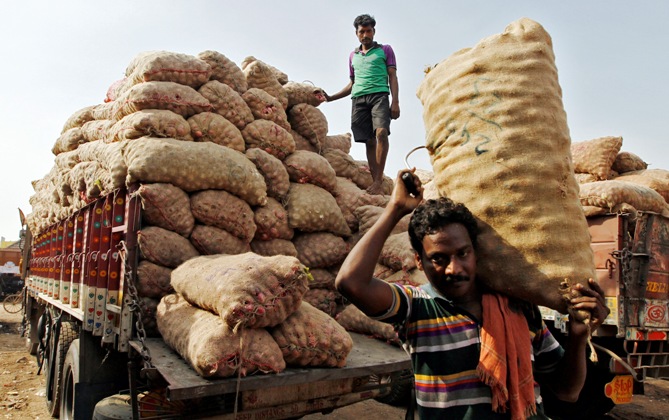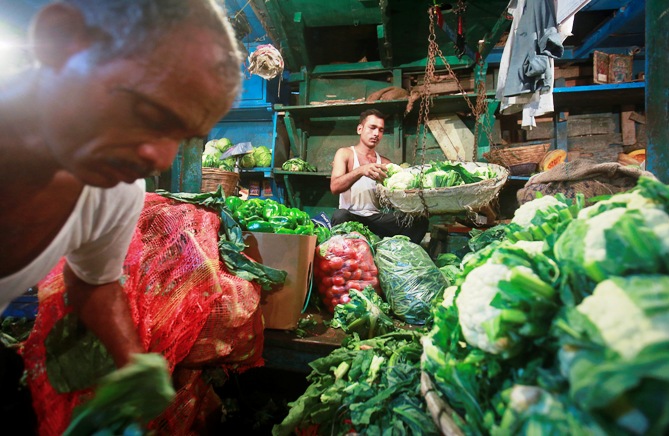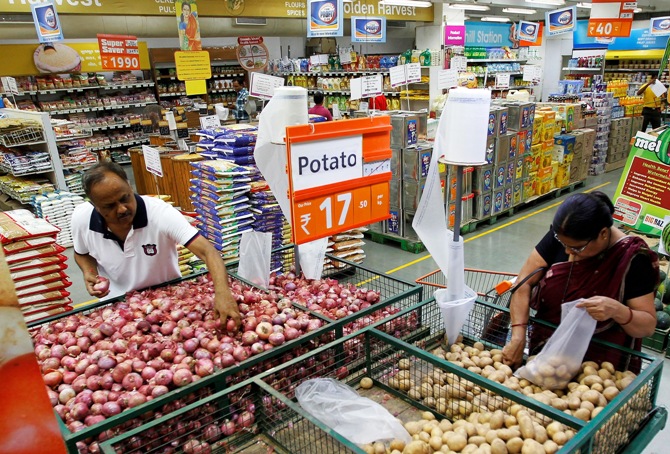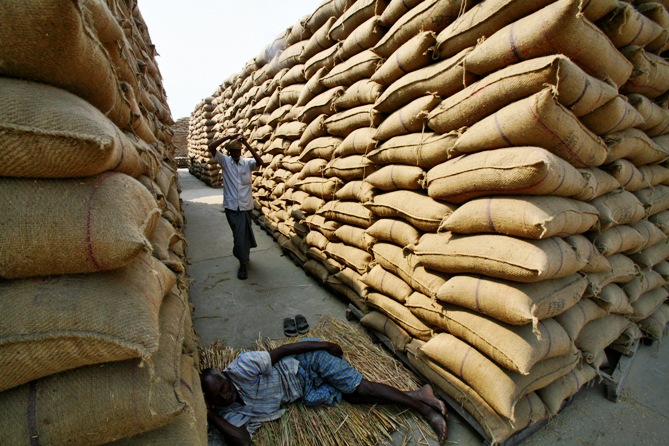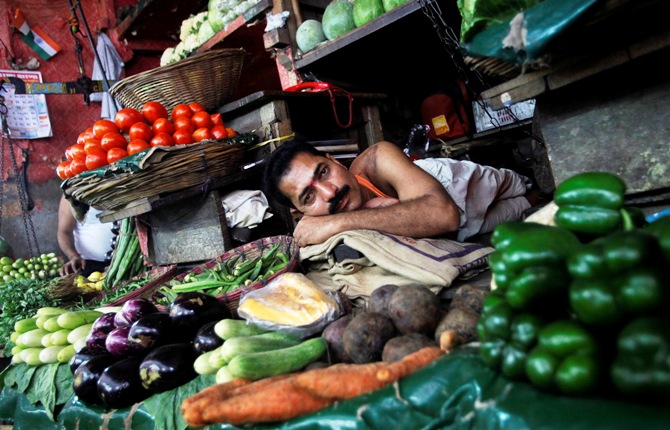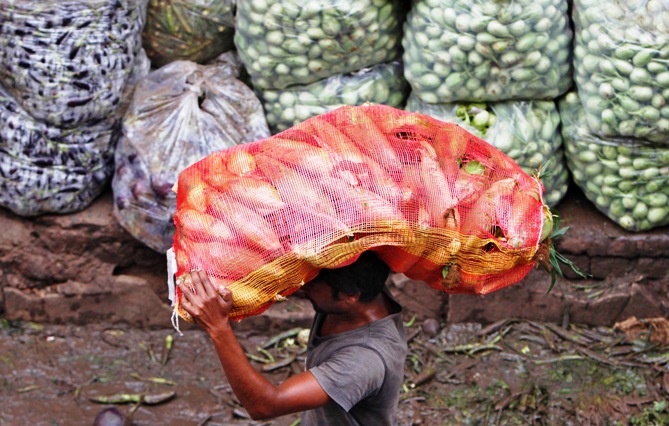 | « Back to article | Print this article |
Vegflation: Another killer for India's economy!
The cause of persistent double-digit food inflation, particularly in vegetables, is the breakdown of competitive markets, rues Shreekant Sambrani
“Eat your greens!” mothers used to sternly admonish reluctant children.
“Don’t ask for greens!” harried Indian mothers might well plead these days.
The once-lowly vegetables have been mightily influencing inflation.
As everyone knows now, their prices rose 46 per cent in October as compared to a year before, and a 35 per cent increase in September.
That has made double-digit food inflation a standard feature of our economic history now for the sixth year.
Consumer prices have now nudged past the 10 per cent mark as well.
As happened last month, news channels will again carry stories and discussions on onions bringing tears.
The usual culprits -- faster increase in demand due to a growing economy and a sluggish supply response, seasonal or natural factors, deficiencies in fresh marketing and storage, rapacious middlemen -- will be brought forth.
Click NEXT to read further. . .
Vegflation: Another killer for India's economy!
But we will not be any wiser as to why last year’s increase was of explosive proportions, since all these factors have perennially affected the horticulture market.
Onions drove India to tears at the onset of the winter of 2009, but the prices then touched the high mark of Rs 50 a kilogramme before receding; other vegetables remained unaffected.
Now even the unfancied brinjal and cluster beans have shot past Rs 50/kg!
K V Thomas, the food minister, said in early October that prices would come down in 10 days.
Agriculture Minister Sharad Pawar said that would happen in three weeks.
They have joined Montek Singh Ahluwalia in making famous price prognostications that predictably go wrong.
All this will not be news to any aam aadmi or aurat who makes periodic pilgrimages to the market.
Click NEXT to read further. . .
Vegflation: Another killer for India's economy!
They have noticed the trends long before the policymakers or media woke up to them.
I have learnt more economics (and humility) from my fortnightly forays into the semi-wholesale fresh market.
I have found prices there to be very reliable and reasonably accurate barometers of economic conditions.
In the 35 years to 2005, the bottom of the market -- the price of the cheapest vegetable -- went up from Rs 0.50/kg to Rs 2/kg. In 2005, it jumped to Rs 4/kg.
It rose to Rs 10/kg by 2010 and now it is over Rs 20, unlikely to come down.
I came to think of this market as the closest real-life approximation of perfect competition, an assessment the late I G Patel shared enthusiastically.
That is no longer true.
Everyone in the chain, from the producer to the one-time fiercely competitive last retailer, indulges in limited hoarding, collusion and oligopolistic behaviour, not countered by the unorganised buyers. I call this phenomenon stealthflation (Business Standard, April 30, 2012).
Click NEXT to read further. . .
Vegflation: Another killer for India's economy!
Some evidence now -- impressionistic as well as more substantial -- supports this hypothesis.
I found crowds in the market much thinner than usual in the last six weeks and the atmosphere subdued.
Vendors, who normally announce their prices aloud, were quieter, as if embarrassed by the high prices.
Since there were fewer customers with relatively lower quantum of purchases, prices would be expected to drop in a competitive market.
That was not happening, even though there was no visible shortage of supplies.
I also found a near 40 per cent drop in the prices of most vegetables just before and after Diwali, with little difference in the quantities bought and sold.
This is a rather new phenomenon.
Click NEXT to read further. . .
Vegflation: Another killer for India's economy!
Further corroboration of the break-down of competitive markets came from that mother of all vegflation, onion markets in Nasik and Dhule districts.
They opened fully after Diwali on November 11.
High arrivals of the precious bulbs in Dhule sent prices tumbling to Rs 2,600 a quintal, arousing the producers into blocking traffic and gherao-ing office-bearers of the Agriculture Produce Marketing Committee.
They relented when traders promised to pay up to Rs 4,200/q depending on the quality. Prices in various Nasik markets, with arrivals of 10,000 to 20,000 quintals, hovered around Rs 3,900/q.
What has changed the picture?
The short-lived crisis of 2010 and the knee-jerk reaction of various governments to corner whatever stocks they could for their urban constituents made the producers aware of the whip hand they held.
Click NEXT to read further. . .
Vegflation: Another killer for India's economy!
Sharad Joshi, of the Shetkari Sanghatana (Farmers’ Organisation) in Maharashtra and indefatigable champion of higher farm prices, wondered why onions should not fetch Rs 100/kg, since a movie ticket that cost Rs 2.50 when the onion price was Re 1/kg is now Rs 250 (Loksatta, “Idea Exchange,” April 1, 2012).
He obviously did not realise that the same specious logic would make the onion price Rs 0.05/kg as well, since phone calls between Nasik and Delhi that used to cost Rs 20 a minute when onions were Rs 0.50/kg, are now only Re 1/min.
The short point is that given this overt exhortation (and only slightly less so from the APMC office-bearers in the growing areas of Maharashtra, mostly from Mr Pawar’s Nationalist Congress Party), producers are united to a considerable extent, traders are as always amenable to manipulations, and the vastly larger mass of consumers are at their mercy.
What is true of onions one day becomes quickly true of other vegetables, thanks to the reach of news television even into the interior.
It requires a little muscle-flexing by Mamata Banerjee about potato export from West Bengal to send the price of this not-so-perishable tuber climbing all over the country in a day or two.
Click NEXT to read further. . .
Vegflation: Another killer for India's economy!
Clearly, prices are now a matter of negotiation and not supply and demand. And so the spiral starts to mount.
Most households have had to adjust downwards with great difficulty.
That has caused resentment and anger, compounded by frustration because no one seems to listen.
More than anything else, this has been the dampener this festive season.
The street smart Narendra Modi has wasted no time in raising a valid question as to when the economist prime minister or the Congress president and vice president addressed this question.
On the other hand, Rahul Gandhi sells Food Security by saying that bharpet roti khayenge without realising that adding hi after roti would be most appropriate since you cannot afford either subzi or daal to accompany your roti!
There is a direct fallout of this.
Click NEXT to read further. . .
Vegflation: Another killer for India's economy!
Recent surveys have all shown an upsurge in the Bharatiya Janata Party’s fortunes.
Most analysts attribute this to Mr Narendra Modi.
In my view, this is really a measure of the general antipathy to the government with a rapid decline in support.
In a zero-sum game of elections, that automatically means gains for the other player, mostly the BJP.
We are now reaching a stage where these trends could become irreversible.
They might well accelerate, making a Modi wave a self-fulfilling (but inaccurate) prophecy.
Inflation is killing not just consumer aspirations, but the Congress’ prospects as well.
In 2004, NDA lost despite a good economic copy book because of Mr Modi, while 10 years later, the same Modi could claim victory because of United Progressive Alliance’s abysmal economic record.
What an irony that would be!
Shreekant Sambrani taught at the Indian Institute of Management, Ahmedabad, and helped set up the Institute of Rural Management, Anand
